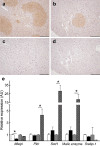Diet-induced gene expression of isolated pancreatic islets from a polygenic mouse model of the metabolic syndrome
- PMID: 19902174
- PMCID: PMC2797618
- DOI: 10.1007/s00125-009-1576-4
Diet-induced gene expression of isolated pancreatic islets from a polygenic mouse model of the metabolic syndrome
Abstract
Aims/hypothesis: Numerous new genes have recently been identified in genome-wide association studies for type 2 diabetes. Most are highly expressed in beta cells and presumably play important roles in their function. However, these genes account for only a small proportion of total risk and there are likely to be additional candidate genes not detected by current methodology. We therefore investigated islets from the polygenic New Zealand mouse (NZL) model of diet-induced beta cell dysfunction to identify novel genes and pathways that may play a role in the pathogenesis of diabetes.
Methods: NZL mice were fed a diabetogenic high-fat diet (HF) or a diabetes-protective carbohydrate-free HF diet (CHF). Pancreatic islets were isolated by laser capture microdissection (LCM) and subjected to genome-wide transcriptome analyses.
Results: In the prediabetic state, 2,109 islet transcripts were differentially regulated (>1.5-fold) between HF and CHF diets. Of the genes identified, 39 (e.g. Cacna1d, Chd2, Clip2, Igf2bp2, Dach1, Tspan8) correlated with data from the Diabetes Genetics Initiative and Wellcome Trust Case Control Consortium genome-wide scans for type 2 diabetes, thus validating our approach. HF diet induced early changes in gene expression associated with increased cell-cycle progression, proliferation and differentiation of islet cells, and oxidative stress (e.g. Cdkn1b, Tmem27, Pax6, Cat, Prdx4 and Txnip). In addition, pathway analysis identified oxidative phosphorylation as the predominant gene-set that was significantly upregulated in response to the diabetogenic HF diet.
Conclusions/interpretation: We demonstrated that LCM of pancreatic islet cells in combination with transcriptional profiling can be successfully used to identify novel candidate genes for diabetes. Our data strongly implicate glucose-induced oxidative stress in disease progression.
Figures





Similar articles
-
Changes in gene expression in beta cells after islet isolation and transplantation using laser-capture microdissection.Diabetologia. 2007 Feb;50(2):334-42. doi: 10.1007/s00125-006-0536-5. Epub 2006 Dec 16. Diabetologia. 2007. PMID: 17180350
-
A High-Fat/High-Sucrose Diet Induces WNT4 Expression in Mouse Pancreatic β-cells.Kurume Med J. 2019 May 16;65(2):55-62. doi: 10.2739/kurumemedj.MS652008. Epub 2019 Mar 11. Kurume Med J. 2019. PMID: 30853690
-
Genetic Drivers of Pancreatic Islet Function.Genetics. 2018 May;209(1):335-356. doi: 10.1534/genetics.118.300864. Epub 2018 Mar 22. Genetics. 2018. PMID: 29567659 Free PMC article.
-
Nutrition-/diet-induced changes in gene expression in pancreatic β-cells.Diabetes Obes Metab. 2012 Oct;14 Suppl 3:57-67. doi: 10.1111/j.1463-1326.2012.01640.x. Diabetes Obes Metab. 2012. PMID: 22928565 Review.
-
Type 1 diabetes in mice and men: gene expression profiling to investigate disease pathogenesis.Immunol Res. 2014 May;58(2-3):340-50. doi: 10.1007/s12026-014-8501-8. Immunol Res. 2014. PMID: 24682832 Review.
Cited by
-
Differential proteomic analysis of the pancreas of diabetic db/db mice reveals the proteins involved in the development of complications of diabetes mellitus.Int J Mol Sci. 2014 May 30;15(6):9579-93. doi: 10.3390/ijms15069579. Int J Mol Sci. 2014. PMID: 24886809 Free PMC article.
-
Cholecystokinin is up-regulated in obese mouse islets and expands beta-cell mass by increasing beta-cell survival.Endocrinology. 2010 Aug;151(8):3577-88. doi: 10.1210/en.2010-0233. Epub 2010 Jun 9. Endocrinology. 2010. PMID: 20534724 Free PMC article.
-
Peroxiredoxin 4, a novel circulating biomarker for oxidative stress and the risk of incident cardiovascular disease and all-cause mortality.J Am Heart Assoc. 2012 Oct;1(5):e002956. doi: 10.1161/JAHA.112.002956. Epub 2012 Oct 25. J Am Heart Assoc. 2012. PMID: 23316297 Free PMC article.
-
Conserved role for the Dachshund protein with Drosophila Pax6 homolog Eyeless in insulin expression.Proc Natl Acad Sci U S A. 2012 Feb 14;109(7):2406-11. doi: 10.1073/pnas.1116050109. Epub 2012 Jan 30. Proc Natl Acad Sci U S A. 2012. PMID: 22308399 Free PMC article.
-
Anti-oxidant effect of nitrite in the pancreatic islets of type 2 diabetic male rats.Iran J Basic Med Sci. 2023 Apr;26(4):420-428. doi: 10.22038/IJBMS.2023.68245.14900. Iran J Basic Med Sci. 2023. PMID: 37009002 Free PMC article.
References
Publication types
MeSH terms
Substances
Grants and funding
LinkOut - more resources
Full Text Sources
Other Literature Sources
Medical
Research Materials
Miscellaneous

